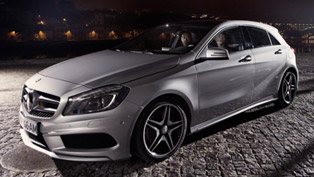Most progressive design in the compact class: 2012 Mercedes-Benz A-Class
Since the new 2012 Mercedes-Benz A-Class debuted last month at the International Geneva Motor Show it made a big furor. What we saw in Geneva was that the car was completely redesigned and didn't even look slightly similar to its predecessor.
The all-new A-Class is going to roll into European market in September this year as we are eagerly waiting to finally see it proudly riding through the streets.
There isn't much similar to the previous designs of the A-Class; however it is important to mentione that the new 2012 Mercedes-Benz A-Class is 18 centimeters closer to the ground. The new radical design change reflects the new Mercedes-Benz design philosophy: a two-box design with a distinct character of its own, a sportily emotive exterior and an astounding high-quality feel to the interior.
In fact, no other car in its segment has made such a significant and progressive change. The result is that now the new A-Class bears the typical for Mercedes sculptural shape, character lines, in particular on its sides and the dynamic style.
The exterior of the vehicle is defined by definite edges and tautly drawn surfaces. The constant interplay between concave and convex surfaces is what makes a characteristic play of light, particularly along the sides of the car, which further emphasizes its unique appearance.
As we can easly see, now the new 2012 Mercedes-Benz A-Class has sportier look, due to its long front and pronounced V-shape, the separate headlamps, the radiator grille with central Mercedes star and double slats to either side of the star, the additional air intakes on the sides. The "dropping line" apparent in the side profile dissipates towards the vehicle's front end. The design of the headlamps combined with the configuration of the light functions within them, is a crucial element of the new design concept.
The characteristic "flare effect" for the daytime running lamps and indicators is made thank to the arrangement of the light modules and LEDs behind the headlamp cover glass. The "flare" is made up of the feature line within the headlamp, the LED modules for the daytime running lamps and the bulb sets for the indicators. All this gives the car dynamic stance and moreover it completely transforms the design of the A-Class.
Furthermore, the 2012 A-Class is additionally defined by excellent aerodynamics. Firstly, one can see this in the roof, which has smooth surfaces and taut, arcing curve. The silhouette reveals smooth, flowing lines finishing in a flat edge. The roof spoiler, which conveniently hides all the aerials, provides an extra sporty touch and gives structure to the roof assembly. Next, the beltline rises to the rear to create a pronounced wedge-shape. Looked from the side, one can see that the car is distinguished by sensuously molded sculptural side panels and crisp lines. The front structural edge, above the wing, falls in what is known as a "dropping line" in a gentle arc towards the rear.
All lines definte the new design philosophy applied on the A-Class, and had given it depth and more dynamism.
The tail end is consists of convex-concave surfaces and edges, and the tail lights continue the line of the muscular shoulders back towards the rear. At the same time their horizontal orientation highlights the car's powerful breadth. The light functions are provided by fiber-optic cables and LED modules. And in addition, the surface finish is a design feature which improves the airflow around the vehicle due to the defined airflow break-away edges in the rear section.
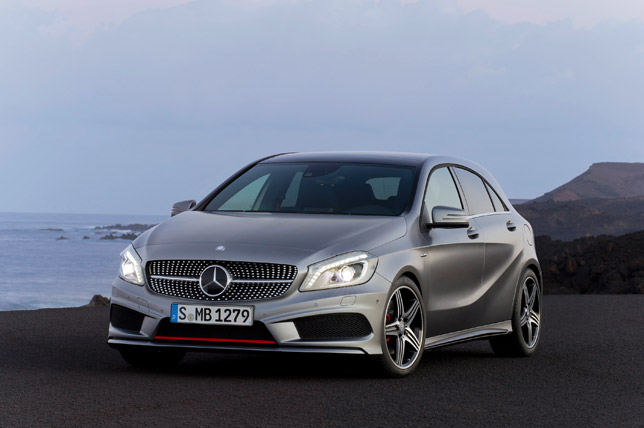
The interior of the new A-Class is worth to be looked-up more closely. The interior sculpture is completely changed as well. At first, the interior was inspired aircraft design. The instrument panel is divided into an upper part, inspired on a wing profile, and a muscular lower section.
What is more important here is that the interior design of the A-Class represents a big step forward in terms of quality. In addition, all trim elements have been given an electroplated finish, resulting in real metal surfaces with "cool touch" effect. The work has been performed with considerable attention to detail, as well.
Next, the instrument panel has five round vents. The outer rings have a high-quality electroplated finish. The airflow direction is governed by an insert that is reminiscent of an aircraft turbine and reveals a meticulous attention to detail. This too has an electroplated finish in silver-chrome. Furthermore, the free-standing display screen features a black piano-lacquer-look front panel and a flush-fitting silver frame.
How about the instrument cluster? It includes two large round instruments, each with a small dial set within it. The dial needles stand at 6 o'clock when it is not working. In addition, the pointer inlays are in white, although with the sportier design and equipment lines such as Urban and AMG Sport they are in red. The dials on the sporty equipment lines and packages are coloured silver with a chequered flag effect.
Furthermore, the three-spoke steering wheel is now equipped with 12 function buttons and an electroplated bezel.
An extensive range of seat coverings, in terms of material (e.g. leather, fabric, Artico/fabric), color combination and also geometry, provides scope for a broad range of individualization options.
For instance, the sports seats with integrated head restraints are available as an optional extra with all design and equipment lines. An opening between the upper edge of the seat backrest and the head restraint further emphasized the sporty nature of the seats. On the back of the front seats this opening is edged with a frame in silver chrome and, in conjunction with the Light and Sight package, can also feature ambient lighting.
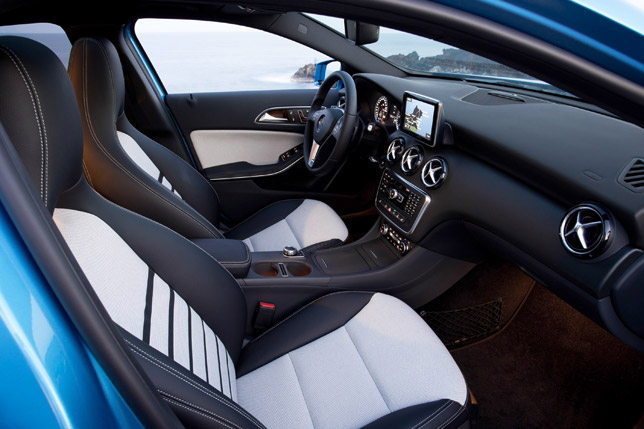
Source: Mercedes-Benz








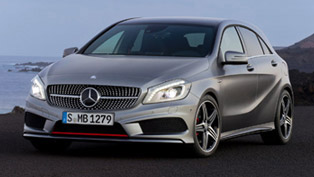
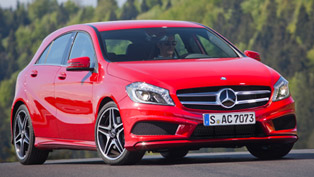
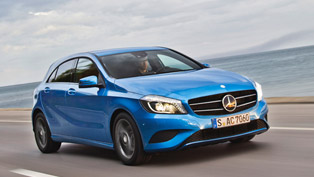
![Mercedes-Benz A-Class Presents: #YOUDRIVE [VIDEO]](http://www.automobilesreview.com/uploads/2012/10/Mercedes-Benz-A-Class-BIG.jpg)
